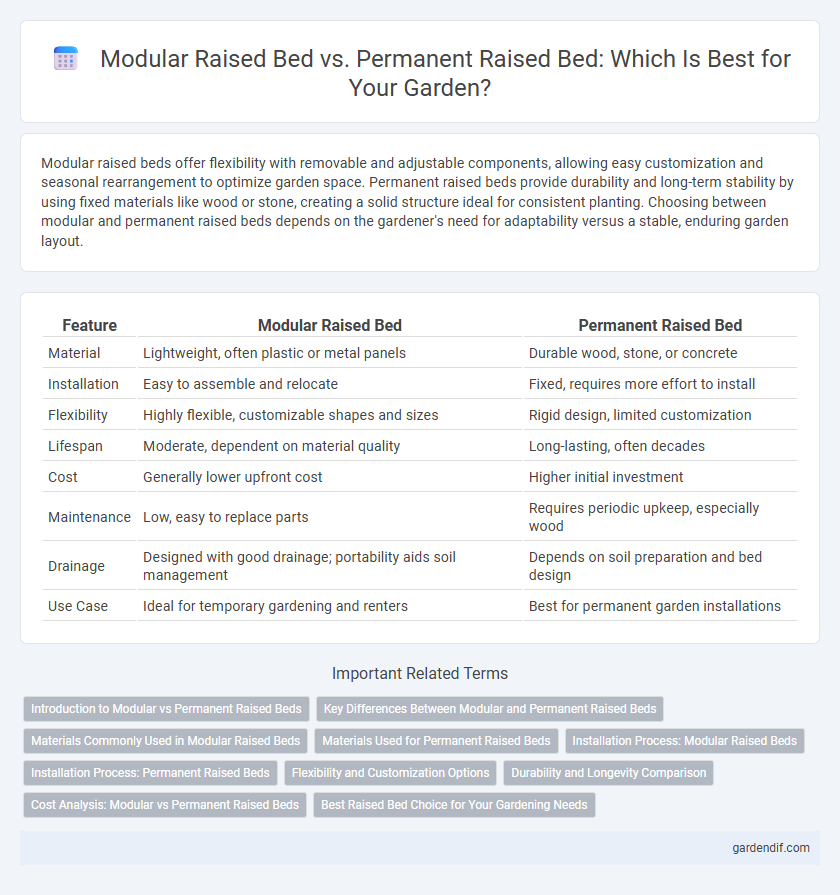
modular raised bed vs permanent raised bed Illustration
Modular raised beds offer flexibility with removable and adjustable components, allowing easy customization and seasonal rearrangement to optimize garden space. Permanent raised beds provide durability and long-term stability by using fixed materials like wood or stone, creating a solid structure ideal for consistent planting. Choosing between modular and permanent raised beds depends on the gardener's need for adaptability versus a stable, enduring garden layout.
Table of Comparison
| Feature | Modular Raised Bed | Permanent Raised Bed |
|---|---|---|
| Material | Lightweight, often plastic or metal panels | Durable wood, stone, or concrete |
| Installation | Easy to assemble and relocate | Fixed, requires more effort to install |
| Flexibility | Highly flexible, customizable shapes and sizes | Rigid design, limited customization |
| Lifespan | Moderate, dependent on material quality | Long-lasting, often decades |
| Cost | Generally lower upfront cost | Higher initial investment |
| Maintenance | Low, easy to replace parts | Requires periodic upkeep, especially wood |
| Drainage | Designed with good drainage; portability aids soil management | Depends on soil preparation and bed design |
| Use Case | Ideal for temporary gardening and renters | Best for permanent garden installations |
Introduction to Modular vs Permanent Raised Beds
Modular raised beds offer flexibility with interchangeable sections that can be easily expanded, relocated, or reconfigured, making them ideal for gardeners seeking adaptable growing spaces. Permanent raised beds provide a sturdy, long-lasting structure often built from durable materials like wood, stone, or concrete, resulting in enhanced stability and minimal maintenance. Choosing between modular and permanent raised beds depends on factors such as available space, desired longevity, and garden design preferences.
Key Differences Between Modular and Permanent Raised Beds
Modular raised beds offer flexibility with easily adjustable components that can be rearranged or expanded, making them ideal for gardeners seeking adaptability in garden layout and seasonal crops. Permanent raised beds are constructed from durable materials like wood or stone, providing long-lasting structure and stability but lacking the ability to be moved or resized once installed. The key differences include material durability, design flexibility, installation complexity, and maintenance needs, impacting suitability depending on garden size, crop rotation, and long-term landscape plans.
Materials Commonly Used in Modular Raised Beds
Modular raised beds are typically constructed using lightweight, durable materials such as cedar, redwood, recycled plastic composites, or galvanized steel, offering flexibility for easy assembly and reconfiguration. These materials resist rot, insects, and weather damage, ensuring longevity while allowing gardeners to expand or relocate beds as needed. Unlike permanent raised beds made from concrete or brick, modular options provide a customizable gardening solution tailored to changing space and plant requirements.
Materials Used for Permanent Raised Beds
Permanent raised beds typically use durable materials such as cedar, redwood, and composite lumber, which resist rot and insect damage, ensuring long-lasting garden structures. Concrete blocks, stone, or bricks are also common choices, providing stability and a timeless aesthetic while withstanding harsh weather conditions. These materials contribute to the structural integrity and maintenance ease of permanent raised beds compared to modular options.
Installation Process: Modular Raised Beds
Modular raised beds feature a straightforward installation process with pre-fabricated panels that easily connect, allowing quick assembly without specialized tools. Their lightweight design and interlocking components enable customization of size and shape, ideal for gardeners seeking flexibility. Unlike permanent raised beds, modular systems require minimal groundwork, reducing setup time and allowing relocation or expansion as needed.
Installation Process: Permanent Raised Beds
Permanent raised beds require a more complex installation process involving durable materials like treated wood, stone, or metal to ensure longevity and stability. Site preparation includes precise leveling, soil amendment, and constructing solid frame foundations that resist weather and pest damage. Installation may take longer and require specialized tools compared to modular raised beds, but results in a stable growing environment ideal for long-term gardening projects.
Flexibility and Customization Options
Modular raised beds provide superior flexibility by allowing users to easily expand, reconfigure, or relocate sections according to changing garden needs, unlike permanent raised beds which are fixed in place. Customization options in modular systems include adjustable sizes, interchangeable materials, and modular connectors that enable personalized garden layouts. Permanent raised beds offer limited adaptability but provide long-term durability and stability for consistent planting areas.
Durability and Longevity Comparison
Modular raised beds offer flexibility with components made from durable materials like cedar or composite wood, allowing for easy repairs or reconfiguration, but their connections may weaken over time. Permanent raised beds, often constructed from concrete, stone, or heavy-duty timber, provide superior longevity and withstand harsh weather without shifting or degrading quickly. Choosing between the two depends on balancing immediate adaptability with long-term structural stability and maintenance requirements.
Cost Analysis: Modular vs Permanent Raised Beds
Modular raised beds typically have a higher upfront cost due to quality materials and ease of assembly, but offer cost savings over time through flexibility and reusability. Permanent raised beds involve lower initial expenses but may require future investments in repairs or replacement due to material degradation. A comprehensive cost analysis weighs initial investment against durability, maintenance, and adaptability to maximize long-term value.
Best Raised Bed Choice for Your Gardening Needs
Modular raised beds offer flexibility and easy customization, allowing gardeners to expand or rearrange their garden layout as needed. Permanent raised beds provide durability and stability, often made from long-lasting materials like cedar or composite wood, ideal for long-term planting areas. Choosing between modular and permanent raised beds depends on your gardening goals, space constraints, and willingness to modify garden design over time.
modular raised bed vs permanent raised bed Infographic

 gardendif.com
gardendif.com